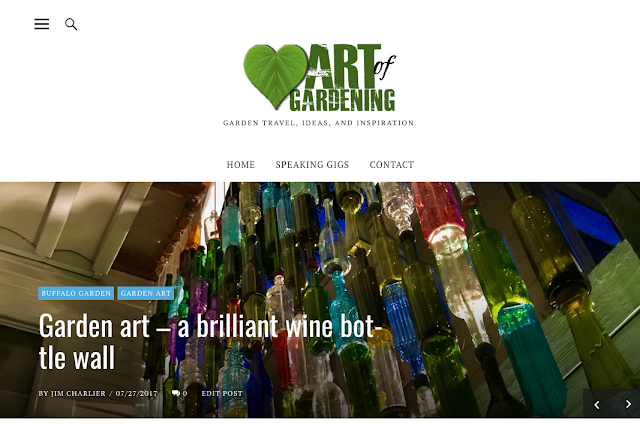Can a garden tour change a city?
Last week, the Buffalo News published, in the Editorial Page, an article written by Randy Hohle, an assistant professor of sociology at D’Youville College. He is working on a research project titled “Rusty Gardens: Creativity, Civic Engagement and Urban Revitalization in the Rust Belt.” And this article was a brief bit about some of the information he has uncovered in the process of researching and interviewing gardeners and garden tour organizers from around the Buffalo Niagara region, as well as in other cities around the country. You can read his full editorial in the Buffalo News here.
One of my favorite quotes from his essay is, "Gardening does not build houses or construct buildings to reshape the physical urban landscape. It only takes impersonal spaces and makes them meaningful, attractive and desirable places to spend our leisure time." Sums it all up pretty well, I think.
But probably the strongest argument for what Garden Walk Buffalo, and other gardening initiatives do for the city can be found in this quote:
Randy's project included interviewing 20 gardeners, involved with garden tours, in Buffalo and Cleveland. He tells me his analysis indicates that Garden Walk has successfully tied together two communities – artists and folks active in voluntary life. Other Garden Walks seem to have either lots of artist creativity but lack the community structure of involvement, or have the community structure (i.e. block clubs) but lack the artistic field.
One question he asked was if gardeners felt an obligation to participate. The vast majority said yes. They explained they felt pressured to participate from neighbors and a sense of civic pride. He sees this as proof that Garden Walk Buffalo has had an independent effect on civic participation. Garden Walk may not have created the original civic pride, but it has definitely enhanced and multiplied it.
19 of his 20 interviewees moved to the city from somewhere else. Some explicitly mentioned that the gardens on the street were the reason they bought their house where they did. A number of gardeners mentioned the increased number of young families with children in the area. This indicates that the urban gardeners are making the city an attractive place to live. Again, while not a direct cause, he did find an indirect effect of Garden Walk making the city a better place to live.
He thinks that’s why Buffalo Garden Walk has been so successful. By fusing the two communities, which may have had some overlap to start with, it has managed bring in new people to constantly replenish the number of members who may drop out for a year or so before returning. It also leads to a community structure of support between residents that produces some spectacular gardens. The result has been a grass-roots, organic, from-the-ground-up movement by citizens that's actually changing the nature of the city of Buffalo (all puns intended).
One of my favorite quotes from his essay is, "Gardening does not build houses or construct buildings to reshape the physical urban landscape. It only takes impersonal spaces and makes them meaningful, attractive and desirable places to spend our leisure time." Sums it all up pretty well, I think.
But probably the strongest argument for what Garden Walk Buffalo, and other gardening initiatives do for the city can be found in this quote:
"And gardening cannot change Buffalo’s national image of a declining postindustrial wasteland the way a winning football or hockey team can. Except when a woman from Ohio told me, after reading a news article about Garden Walk Buffalo, “I was aware that this article was already changing my impression of Buffalo” before ever visiting the city. I have yet to hear similar remarks about the Bills or Sabres."
Randy's project included interviewing 20 gardeners, involved with garden tours, in Buffalo and Cleveland. He tells me his analysis indicates that Garden Walk has successfully tied together two communities – artists and folks active in voluntary life. Other Garden Walks seem to have either lots of artist creativity but lack the community structure of involvement, or have the community structure (i.e. block clubs) but lack the artistic field.
 |
19 of his 20 interviewees moved to the city from somewhere else. Some explicitly mentioned that the gardens on the street were the reason they bought their house where they did. A number of gardeners mentioned the increased number of young families with children in the area. This indicates that the urban gardeners are making the city an attractive place to live. Again, while not a direct cause, he did find an indirect effect of Garden Walk making the city a better place to live.
He thinks that’s why Buffalo Garden Walk has been so successful. By fusing the two communities, which may have had some overlap to start with, it has managed bring in new people to constantly replenish the number of members who may drop out for a year or so before returning. It also leads to a community structure of support between residents that produces some spectacular gardens. The result has been a grass-roots, organic, from-the-ground-up movement by citizens that's actually changing the nature of the city of Buffalo (all puns intended).








Thank you for bringing to my attention this essay, needless to say I'm brimming with pride. Here's to changing peoples perception of any city by way the power of a flower! Flower power redefined, lol.
ReplyDeleteCongratulations, Jim! That is a wonderful editorial, and further proof that all of your (and every gardener's) hard work is paying off.
ReplyDeleteHey I've never been to Buffalo but ever since I came across your blog and found out about the whole Garden thing you people are doing I would want to visit it if only for the plants.
ReplyDelete